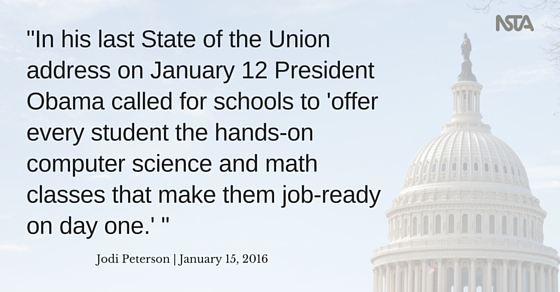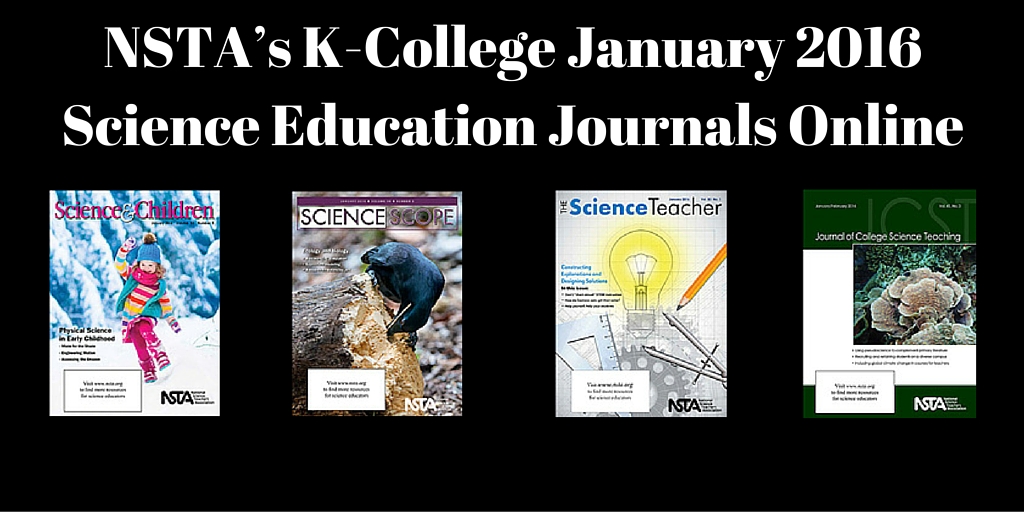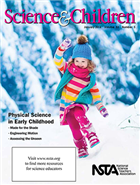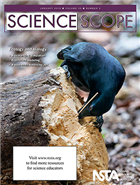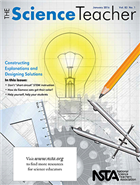President Obama Gives Shout Out to Computer Science and STEM in SOTU
By Jodi Peterson
Posted on 2016-01-15
In his last State of the Union address on January 12 President Obama called for schools to “offer every student the hands-on computer science and math classes that make them job-ready on day one.”
The President also mentioned the newly defunct No Child Left Behind, calling the new education bill (Every Student Succeeds Act) an important start, and pointed out his achievements to increase childhood education, lift high school graduation rates, and “boost graduates in fields like engineering.”
Following the State of the Union address, Acting U.S. Secretary John King kicked off his “Opportunity Across America” tour to discuss the Every Student Succeeds Act (ESSA).
According to the White House Office of Science and Technology, “Our economy is rapidly shifting, and educators are increasingly recognizing computer science as the new basic. There are over 600,000 high-paying technology jobs open across the U.S., and by 2018, 51 percent of all STEM jobs are projected to be in computer science-related fields. However, computer science (CS), is taught in less than 25 percent of American K-12 schools, even as other advanced economies, such as Britain, are making it available for all students aged 5-16. In addition, students of color, girls, and students in high-need schools are less likely to take computer science than other students, and few middle school or elementary schools offer any computer science experiences.”
Additional White House outreach to expand computer science education is expected soon.
In related news, the Computer Science Teachers Association, the Association for Computing Machinery, and Code.org are joining forces to create a K-12 Computer Science framework for educators and policy makers. Working with advisors within the computing community, and with several states and large school districts, technology companies, and other organizations, the groups will create a framework that will identify key K-12 computer science concepts and practices students should know at the end of grades 2, 5, 8, and 12.
Update on Every Student Succeeds Act
The Department of Education is busy drafting regulations for the ESSA, and advocates called on ED officials to ensure the new law is properly enforced during two public hearings this past week.
In December, ED issued a Dear Colleague Letter to states to clarify some questions (largely about Title I) about transitioning to the new law. The rule-making process is now underway, and teachers and teacher leaders can provide recommendations about the implementation of the new law until January 21. Draft regulations are expected out this spring. ESSA provisions will take effect at the start of the 2017-18 school year. Waivers to NCLB will end on August 1, 2016.
Supreme Court Hears Arguments on Union “Fair Share” Fees
Last week the Supreme Court heard oral arguments in the Friedrichs v. California Teachers Association case that could bar public-sector unions from collecting “fair-share” fees from non-members, a move that Politico says “could reduce union membership drastically and drain union coffers.”
Read more about the Supreme Court hearing last week, this EdSource background story on the case, and the NEA response.
Jodi Peterson is Assistant Executive Director of Legislative Affairs for the National Science Teachers Association (NSTA) and Chair of the STEM Education Coalition. e-mail Peterson at jpeterson@nsta.org; follow her on Twitter at @stemedadvocate.
The mission of NSTA is to promote excellence and innovation in science teaching and learning for all.
Follow NSTA
Students communicate their results
By Mary Bigelow
Posted on 2016-01-10
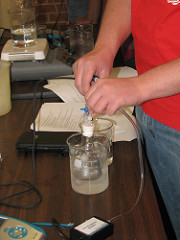 I am interested in strategies to help students write lab reports. I have gone over this at the beginning of the year and a few times in between. But students still have trouble explaining the purpose, hypothesis, process, and conclusion. I want the students to describe and analyze their lab activities and to communicate their findings. Any help will be appreciated. —M., Wisconsin
I am interested in strategies to help students write lab reports. I have gone over this at the beginning of the year and a few times in between. But students still have trouble explaining the purpose, hypothesis, process, and conclusion. I want the students to describe and analyze their lab activities and to communicate their findings. Any help will be appreciated. —M., Wisconsin
Many older textbooks provide templates for students to fill in during “labs” but these do little in terms of students creating their own reports to summarize and reflect on their investigations. The Next Generation Science Standards describe eight practices of scientists and engineers investigating phenomena and solving problems, including carrying out investigations, analyzing and interpreting data, constructing explanations/designing solutions, and obtaining, evaluating, and communicating information. If students do not have much experience in these practices, they will need guidance and scaffolding to become proficient.
When I started teaching, I was excited about doing inquiry-based investigations. But my middle school students were similar to yours. They were confused about observations vs. inferences, and their conclusions were simple summaries of their observations. I did a lot of reflecting: Are my students academically clueless? Am I expecting too much of middle school students?
After observing my students during a few activities, I concluded that my explanations and guidance were insufficient, given that many students were not experienced in basic skills such as questioning, observing, summarizing, formulating hypotheses, graphing, or drawing conclusions. In earlier grades the students did cookbook activities where the purpose and procedures were already determined and the data tables already set up. They may have used some skills in isolation with few opportunities to apply the skills in new situations. Their written reports reflected this lack of experience.
Once you have observed your students and identified baseline data on the skills your students do or do not have, you can begin to scaffold your students’ learning with direct instruction to help them acquire the missing skills, guided practice in a variety of contexts, and opportunities to choose and use the skills independently (even if they make a few mistakes). Here are some ideas:
- Use guiding questions, prompts, and templates to help students focus their thinking. For hypotheses, the template If [I do this], then [this] will happen can show students that a hypothesis is not just an “educated guess.” Show them the difference between testable and untestable questions.
- Share an example of a well-written report on a current investigation. Discuss what makes it a useful documentation of the activity. Share another example of an incomplete or inaccurate one as a comparison.
- Do class demonstrations as a model so the students can observe and focus on a written description, including the list of materials, the procedure, and data tables. Have them compare their descriptions.
- After lab groups conduct an investigation, have students work in their groups to collaboratively write one part of the report (e.g., introduction, methods/materials, observations, results). Ask the groups working on a particular section such as the introduction to read their writing out loud, display it on the board, or use online collaborative tools. Then as a class discuss the section’s strengths and what could be improved.
- Use guiding prompts and questions about the investigation and their data or observations to help students formulate their conclusions.
- Provide students with a rubric or checklist of what should be included in their reports. At first, focus the rubric on specific skills (organizing data, describing the procedure, or formulating a question or hypothesis) and gradually build up to a complete document.
- As an alternative to formal reports, students could communicate about the investigation through posters or infographics.
- Have the students collaboratively write the purpose, question/hypothesis, materials and procedure and then collect data/observations from the lab. For the conclusion, each student supports a conclusion with evidence (data/observations) from the lab.
The investigations will have little learning value unless students make the connections to the content and relate what they’re doing to the performance expectations. Eventually, most students should be able to write a complete lab report. This takes time and patience, but your efforts will pay off when you (and the students) see what they are able to do.
Rich source for lesson plans?
By Peggy Ashbrook
Posted on 2016-01-09
Do you “Pin?”
![]() Early childhood preservice teachers on the NSTA Learning Center forums are recommending Pinterest as a source for lesson plans and activities: “Dig into pinterest!!!! It has been my best friend as a student teacher this year!”
Early childhood preservice teachers on the NSTA Learning Center forums are recommending Pinterest as a source for lesson plans and activities: “Dig into pinterest!!!! It has been my best friend as a student teacher this year!”
How can educators looking for science explorations or science content knowledge find resources that are supported by the fabulous research into how children learn? In “An Open Letter: To Pinterest, from a Teacher,” blogger Mary Wade wrote about her questions that help her choose more “truly inspiring, learning-based” Pinterest pins, questions such as:
- Will this help me better understand and reach my students?
- Will this enhance student ownership over learning?
Will this encourage the 4 C’s (critical thinking, communication, collaboration, or creativity)?” - Will this help my students investigate concepts?
- Is this centered more on empowering student-directed learning, or on getting students to sit still and listen?
Science Educator Maureen Stover shared her “mental checklist” that she uses when evaluating any internet resource, in an NSTA Learning Center forum comment:
- Is this an activity/resource that meets my lesson objective/goal?
- Is this activity on grade level (or can I easily modify it)?
- Is this activity reasonable to complete in my classroom?
- Is this activity safe?
- Is this activity affordable?
- Will this activity engage my students?
Maureen also tries to validate the content knowledge information from several sources to ensure the information is accurate.
I am going to try to make my Pinterest pin choices richer by reflecting on Mary Wade’s questions, and using Maureen Stover’s questions to be sure I add information about the concepts in the activity, links to the source and research about ECE, and explain how the science activity extends student understanding.
What makes a Pinterest pin a valuable resource for you?
Do you “Pin?”
![]() Early childhood preservice teachers on the NSTA Learning Center forums are recommending Pinterest as a source for lesson plans and activities: “Dig into pinterest!!!! It has been my best friend as a student teacher this year!”
Early childhood preservice teachers on the NSTA Learning Center forums are recommending Pinterest as a source for lesson plans and activities: “Dig into pinterest!!!! It has been my best friend as a student teacher this year!”
NSTA’s K-College January 2016 Science Education Journals Online
By Korei Martin
Posted on 2016-01-06
Looking for ways to engage preschool students in physical science? Are your students curious as to how animals communicate and make decisions? Want to expand your students interest in engineering? Looking for new ways for undergraduate teaching assistants to work with college students in entry-level STEM courses? The January K–College journals from the National Science Teachers Association (NSTA) have the answers you need. Written by science teachers for science teachers, these peer-reviewed journals are targeted to your teaching level and are packed with lesson plans, expert advice, and ideas for using whatever time/space you have available. Browse the January issues; they are online (see below), in members’ mailboxes, and ready to inspire teachers!
Starting in preschool, teachers can engage students in physical science through creative, hands-on lessons. This issue of S&C delves into physical science lessons that involve derby cars, UV-sensitive lizards, and more.
Featured articles (please note, only those marked “free” are available to nonmembers without a fee):
- Free – Addressing Three Common Myths About the Next Generation Science Standards
- Assessing the Unseen
- Free – Editor’s Note: Early Childhood Physical Science
- How We Know What We Know
- Made for the Shade
- Seeing the Solar System Through Two Perspectives
- Table of Contents
New Caledonian crows are master tool makers and users. They have even been known to stash their favorite tools in the hollows of trees so they can be retrieved and reused for another meal. Check out this issue’s Tried and True column for a crow-foraging activity that is sure to engage and inform your students as they explore animal communication, cooperation, and decision-making.
Featured articles (please note, only those marked “free” are available to nonmembers without a fee):
- A Biomedical Engineering Twist to Science Fairs
- Free – Addressing Three Common Myths About the Next Generation Science Standards
- Eco-Choices: Understanding the Complex Consequences of Local Decisions
- Free – Editor’s Roundtable: More Than Just a Chart
- Modeling Ecosystems
- Outbreak! Cells, Pathogens, and Disease
- Table of Contents
Science is all about asking questions and constructing explanations, while engineering focuses on defining problems and designing solutions. Think of science as the quest for timeless truths and engineering as the search for design solutions to problems rooted in a particular time and situation. To be sure, there is overlap. Scientists often must complete engineering tasks such as designing experimental apparatus and testing prototypes, and engineers sometimes explore new phenomena and develop scientific models. In our schools we need to educate students about engineering careers, especially our young women, who are dramatically underrepresented in engineering fields. We cannot waste precious human capital by creating another generation of students who can say, “I have no idea what an engineer is.”
Featured articles (please note, only those marked “free” are available to nonmembers without a fee):
- Addressing Three Common Myths About the Next Generation Science Standards
- Free – Don’t “Short Circuit” Stem Instruction
- Free – Editor’s Corner: Constructing Explanations and Designing Solutions
- Health Wise: Spotting Depression in High School Students
- Help Yourself, Help Your Students
- How Do Siamese Cats Get Their Color?
- Table of Contents
Journal Of College Science Teaching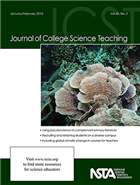
Read about a study that investigated the learning gap between students with strong prerequisite skills and students with weak prerequisite skills and concluded that these skills are critical to subsequent learning. See the Research and Teaching article that examines the development of peer mentoring skills and deepening of content knowledge by trained undergraduate teaching assist
ants working with students in entry-level STEM courses. And don’t miss the Case Study that looks at a flipped classroom approach in which students both produce and watch videos in preparation for class.
Featured articles (please note, only those marked “free” are available to nonmembers without a fee):
- Crossing Boundaries in Undergraduate Biology Education
- Point of View: Predictably Unpredictable
- Research and Teaching: Computational Methods in General Chemistry: Perceptions of Programming, Prior Experience, and Student Outcomes
- Research and Teaching: Correlations Between Students’ Written Responses to Lecture-Tutorial Questions and Their Understandings of Key Astrophysics Concepts
- Research and Teaching: Development of Undergraduate Teaching Assistants as Effective Instructors in STEM Courses
- Free – Strategies to Recruit and Retain Students in Physical Science and Mathematics on a Diverse College Campus
- Table of Contents
Get these journals in your mailbox as well as your inbox—become an NSTA member!
The mission of NSTA is to promote excellence and innovation in science teaching and learning for all.
Follow NSTA
Earth's Changing Surfaces
Cells and Chemical Reactions
Atomic Structure
Do You Have Adequate Time to Teach Science in Middle School?
By Guest Blogger
Posted on 2016-01-04
 “I have all the time I need to teach my science content and processes,” said no teacher, ever! When I was an elementary teacher, I often felt pressured to spend more time on math and reading than on science because, after all, those were the subjects tested most often by the state. So, I did my best to weave science into the math and reading curriculum, whenever I could. However, I never felt that my students received the depth of what I could expose them to with additional time.
“I have all the time I need to teach my science content and processes,” said no teacher, ever! When I was an elementary teacher, I often felt pressured to spend more time on math and reading than on science because, after all, those were the subjects tested most often by the state. So, I did my best to weave science into the math and reading curriculum, whenever I could. However, I never felt that my students received the depth of what I could expose them to with additional time.
Moving to middle school, grade six, I was thrilled to think that I had dedicated time for science because we were governed by a bell schedule. However, as testing season came around, students were pulled from classes to receive interventions for, you guessed it, math and reading.
Do We Need Dedicated Science Time?
So the question becomes, do we really need that time? The answer is a resounding yes! In, A Framework for K-12 Science Education: Practices, Crosscutting Concepts, and Core Ideas, published by the National Research Council of the National Academy of Sciences, the committee emphasizes that greater improvements in K-12 science and engineering education will be made when all components of the system—from standards and assessments, to support for new and established teachers, to providing sufficient time for learning science—are aligned with the framework’s vision. In, Successful K-12 STEM Education: Identifying Effective Approaches in Science, Technology, Engineering, and Mathematics, published by the National Research Council of the National Academy of Sciences, the report states, “Overall, the decrease in time for science education is a concern because some research suggests that interest in science careers may develop in the elementary school years. School districts should devote adequate instructional time and resources to science in grades K-5.” The NSTA Position Statement for Science Education for Middle Level Learners recommends that middle level administrators support their science programs by “supporting the recommended time allotted for middle level laboratory investigations.
As middle level educators, some of us may be in a K-6 building, while others may be at 6-8, or even 7-9 buildings. What can we do to promote the allotment of adequate instructional time? Knowledge is power, as the old adage goes. Arm yourselves with the data and research that supports your assertion and ask to have a discussion with your administrators. According to the, Improving STEM Curriculum and Instruction: Engaging Students and Raising Standards, brief by the Community for Advancing Discovery Research in Education, “The problem is not simply academic; it is economic. If the U.S. fails to increase the number of students mastering STEM content and preparing for STEM careers, the nation will fall farther and farther behind in the global economy—and that affects us all.” Raising the awareness of our administrators, school boards and parents is one of the first steps to creating change.
What are some ways YOU have addressed the issues of adequate instructional time for science? Please share your comments with us.
 Mary Patterson, a 2014-2015 Albert Einstein Distinguished Educator Fellow, 2014-2015 PBS Digital Innovator, and 2009 NOAA Teacher at Sea, has over 30 years of classroom teaching experience at both the elementary and middle school levels. Currently, she is the Campus Content Instructional Specialist for Science, Grades 6 through 8, at Hopper Middle School in Cypress Fairbanks ISD in Cypress, Texas.
Mary Patterson, a 2014-2015 Albert Einstein Distinguished Educator Fellow, 2014-2015 PBS Digital Innovator, and 2009 NOAA Teacher at Sea, has over 30 years of classroom teaching experience at both the elementary and middle school levels. Currently, she is the Campus Content Instructional Specialist for Science, Grades 6 through 8, at Hopper Middle School in Cypress Fairbanks ISD in Cypress, Texas.
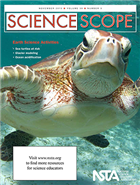 Get more involved with NSTA! Join today and receive Science Scope, the peer-reviewed journal just for middle school teachers; connect on the middle level science teaching list (members can sign up on the list server); or consider joining your peers for Meet Me in the Middle Day (MMITM) at the National Conference on Science Education in Nashville this spring (sign up to present at MMITM here).
Get more involved with NSTA! Join today and receive Science Scope, the peer-reviewed journal just for middle school teachers; connect on the middle level science teaching list (members can sign up on the list server); or consider joining your peers for Meet Me in the Middle Day (MMITM) at the National Conference on Science Education in Nashville this spring (sign up to present at MMITM here).



